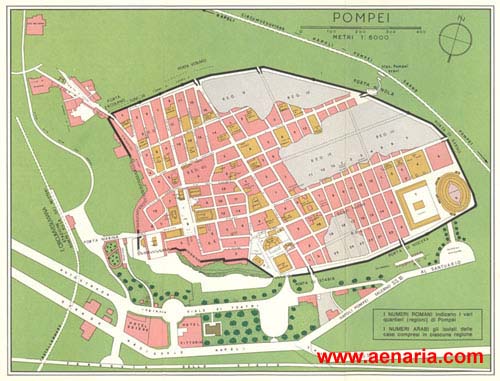|
|
 |
|
Roman Atrium Style Housing |
|
written
by laured / 09.03.2004 |
|
|
| |
Introduction |
| |
| |

|
|
| The Layout of Pompeii |
|
| |
|
Pompeii and Herculaneum:
Thanks to the eruption of Mt. Vesuvius in AD 79, the remains of Pompeii and Herculaneum are well preserved. In Pompeii, life stopped very suddenly when it poisonous gasses, hot stones and ashes falling from Vesuvius quickly struck the city. The eruption of Vesuvius affected Herculaneum differently. Closer to the volcano, Herculaneum was completely flooded by mud, which eventually solidified. The buried ancient city was perfectly preserved, guarded from the harsh outside environment and illegal excavators. Because of the mud, Herculaneum was preserved better than Pompeii.
Both Herculaneum and Pompeii provide invaluable information about Ancient Rome, however, as one could imagine, it is very difficult to excavate these areas, and much is still buried today. Most of what we know about Roman Atrium style housing comes from these areas. And, based on evidence from other reaches of the Roman Empire, it is assumed that the remains of Pompeii and Herculaneum represent Roman-style housing very well. Therefore, we study the housing in those areas to gain an overall understanding of what houses were like in throughout the entire Roman Empire.
We learn different things from Pompeii than we do Herculaneum. Both towns were resorts for Roman aristocrats towards the end of the first century B.C. Herculaneum, however, was a fifth smaller than Pompeii, and was home to only four to five thousands inhabitants. Also unlike, Herculaneum was very devoted to navy and fishing and was considered more peaceful than Pompeii, which was full of brothels and the like. It was especially beautiful because it overlooked the gulf, and was full of greenery and vineyards. It is said, in fact, that Herculaneum was Epicure's favorite place for his philosophical studies.
City versus Country Living:
In Rome, approximately 2,000 wealthy families lived in elaborate atrium-style country villas or huge town homes (domus). These Roman Atrium-style homes had many rooms with specific functions, which fit the needs of the owner. The 46,000 poor lived in flats called insule. Insule were apartments. Wooden insule typically ranged from two of three stories high, but concrete buildings were as high as seven stories. Height restrictions were due to the frequent collapsing floors, and devastating fires. Ovens were consequently not allowed in the apartments, so apartments dwellers often ate in one of many nearby taverns.
Though much attention is paid to city dwellers, it is important to consider those who lived in the country. In fact, only about ten percent of the Roman Empire’s population in the lived in the city. The rest of the population lived in the countryside, in either humble houses or ornate villas, rivaling those in the city. These villas had three parts, called villa urbana, villa rustica, and storage accommodations. The villa urbana where the owners resided, and tended to strongly resemble the grand domus. The other parts of the house were less ornate. The villa rustica housed the staff and animals, and also often included a small hospital and prison.
|
| |
|
| |
|
|
 |
|

